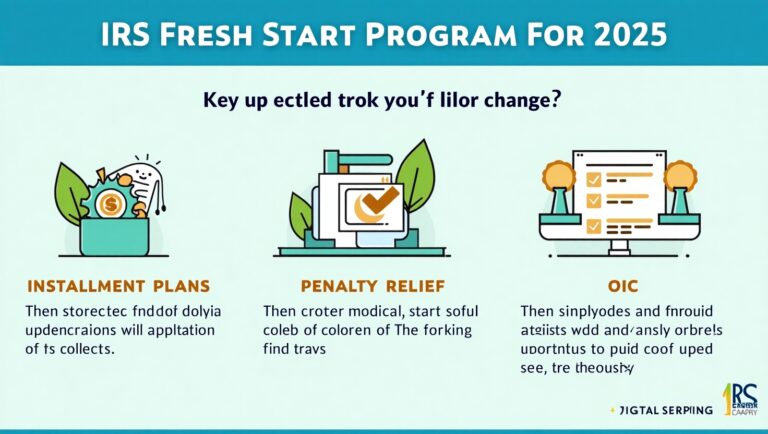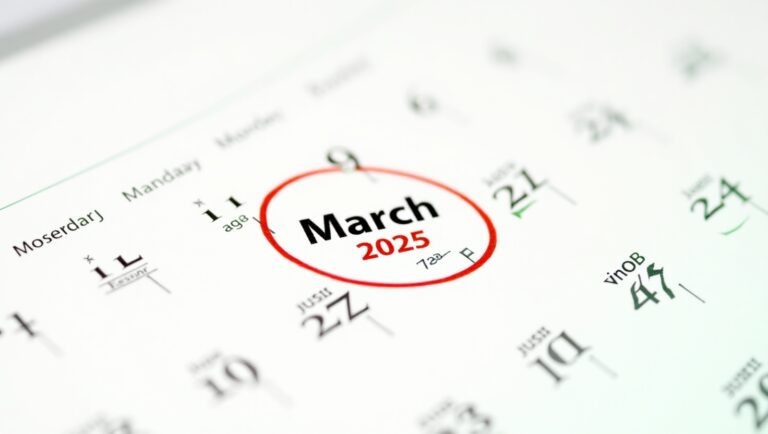Introduction: Understanding the IRS Fresh Start Program
For US taxpayers struggling with tax debt, the IRS Fresh Start Program offers a beacon of hope. This initiative was designed to make it easier for taxpayers to resolve their financial obligations with the IRS, reduce penalties, and avoid the harsh consequences of tax debt. While the program has been around for several years, 2025 brings new changes that expand its reach and improve the relief options for taxpayers. In this blog post, we’ll walk you through what the IRS Fresh Start Program is, the key changes for 2025, and how US taxpayers can take advantage of these new provisions.

What is the IRS Fresh Start Program?
The IRS Fresh Start Program was introduced to provide struggling taxpayers with a way to manage and settle their tax debts without facing severe penalties, liens, or other enforcement actions. This program includes various options like installment agreements, Offer in Compromise (OIC), and penalty relief.
The core goal of the program is to help US taxpayers who owe back taxes by offering more flexible repayment options, reducing penalties, and, in some cases, settling for less than the full amount owed. This initiative is a lifeline for taxpayers who are experiencing financial difficulties but are unable to pay off their debts all at once.

Key Changes to the IRS Fresh Start Program in 2025
The IRS Fresh Start Program has evolved over time, and 2025 brings a series of important changes aimed at offering even more relief to struggling US taxpayers. These changes expand eligibility, streamline application processes, and offer more flexible repayment options. Some of the most significant changes include:
- Increased income limits for Offer in Compromise (OIC): In 2025, more taxpayers can qualify for an OIC, a program that allows you to settle your tax debt for less than the amount owed.
- Simplified Installment Agreements: The IRS has made it easier for taxpayers to set up affordable payment plans without excessive paperwork or complex requirements.
- Penalty Relief: For taxpayers who have accrued penalties for late filing or payment, the IRS is offering more leniency in 2025, allowing them to reduce or eliminate penalties under certain conditions.
These changes are designed to ensure that US taxpayers struggling with debt have a greater chance of getting back on track and avoiding unnecessary financial hardship.

Eligibility Requirements: Who Can Benefit from the Program in 2025?
To qualify for the IRS Fresh Start Program in 2025, taxpayers must meet certain eligibility criteria. While these criteria have expanded, it’s important to understand that not all taxpayers will automatically qualify for every relief option. However, the updated program opens the door for more individuals.
Here are some key eligibility details:
- Taxpayers with tax debt of $50,000 or less: Many of the streamlined options, like installment agreements and OIC, are available to taxpayers who owe less than $50,000 in tax debt. This is an increase from the previous limit, which means more taxpayers can access relief.
- Current Income & Asset Limits for OIC: For the Offer in Compromise program, the IRS has raised the income and asset thresholds, meaning more taxpayers can qualify for this debt settlement option. Taxpayers with limited income or assets now have a better chance of resolving their tax debts for a fraction of what they owe.
- Taxpayers who can demonstrate financial hardship: Those who can show that paying their full tax debt would result in financial hardship will generally be eligible for reduced payment plans or settlement options.
For more detailed eligibility requirements, you can visit the IRS Fresh Start Program webpage.

Expanded Installment Agreements: More Flexible Payment Plans
One of the biggest changes in the IRS Fresh Start Program for 2025 is the expansion of installment agreement options. These agreements allow US taxpayers to pay off their tax debt in smaller, more manageable monthly payments instead of all at once.
Under the new provisions, US taxpayers can access streamlined installment agreements with fewer requirements. These are ideal for individuals who cannot pay their tax debt upfront but want to avoid penalties and other collection actions like liens or levies.
Key benefits of the expanded installment agreements include:
- No need for detailed financial disclosure: Many taxpayers can now qualify for streamlined agreements without needing to provide a comprehensive financial statement.
- Longer repayment terms: The IRS has extended the terms for some installment agreements, giving taxpayers more time to pay off their debt without incurring additional interest or penalties.
This change makes the Fresh Start Program more accessible and manageable for US taxpayers who need time to pay off their obligations.
Offer in Compromise (OIC): Settling Your Tax Debt for Less
The Offer in Compromise (OIC) program allows US taxpayers to settle their tax debt for less than the full amount owed. This is particularly helpful for taxpayers who are facing extreme financial hardship and cannot afford to pay their full tax liability.
In 2025, the IRS has made it easier to qualify for an OIC by raising the income and asset limits. This means more taxpayers will have the opportunity to settle their tax debts for a reduced amount, making it an attractive option for those struggling to make payments.
To qualify for an OIC, taxpayers must demonstrate that they cannot pay the full amount due and that settling for less is in the best interest of both the taxpayer and the IRS. The IRS will evaluate your offer based on your income, expenses, and overall financial situation.
For more information on how to apply for an OIC, visit the IRS OIC page.
Penalty Relief: Reducing the Financial Burden
Many US taxpayers who fall behind on their taxes end up facing hefty penalties for late filing or payment. These penalties can compound the financial burden, making it even harder for individuals to get back on track. Fortunately, the IRS Fresh Start Program in 2025 includes expanded penalty relief options.
In 2025, the IRS has increased the flexibility around penalty reductions for those who meet specific criteria. These may include:
- First-time penalty abatement: Taxpayers who have a clean record and are facing penalties for the first time may qualify to have those penalties reduced or waived.
- Reduced penalties for financial hardship: Taxpayers who can show that paying penalties would cause financial hardship may be eligible for penalty relief.
This change can significantly ease the burden on struggling taxpayers by lowering the amount they owe and helping them get back on track faster
How the IRS Fresh Start Program Can Help You Get Back on Track
The IRS Fresh Start Program provides US taxpayers with the tools they need to overcome tax debt and regain their financial stability. By offering options like flexible payment plans, OIC settlements, and penalty relief, the program ensures that struggling taxpayers have a path forward.
For many taxpayers, the stress of tax debt can be overwhelming, and the Fresh Start Program provides a second chance to settle debts on manageable terms. Whether you’re dealing with a large tax bill or facing penalties, this program is designed to offer relief and help you get back on the path to financial security.

Step-by-Step Guide: How to Apply for the IRS Fresh Start Program
Applying for the IRS Fresh Start Program can be a straightforward process if you follow these steps:
- Review your tax situation: Determine how much tax debt you owe and assess your financial situation to figure out which relief options you qualify for.
- Choose the appropriate relief option: Whether it’s an installment agreement, Offer in Compromise, or penalty relief, choose the option that best fits your circumstances.
- Gather necessary documents: You may need to provide financial documentation, such as income statements, tax returns, and proof of expenses.
- Submit your application: Follow the IRS guidelines to submit your application for the Fresh Start Program. You can apply online or by mail.
- Wait for approval: Once the IRS reviews your application, they will notify you of their decision. If approved, you’ll receive instructions on how to proceed with your payment plan or settlement.
For more detailed instructions on applying, check out the IRS application page.
Conclusion: Why 2025 Is the Year to Take Advantage of IRS Relief
If you’re a US taxpayer struggling with tax debt, 2025 offers a prime opportunity to take advantage of the IRS Fresh Start Program’s expanded provisions. With more flexible payment plans, higher thresholds for Offer in Compromise, and increased penalty relief, there’s never been a better time to resolve your tax debt.
Don’t wait until your tax issues spiral out of control. The Fresh Start Program can help you regain control of your finances and avoid the stress of ongoing debt. Consider your options, apply for relief, and start your journey toward financial freedom today.
Click here : Lululemon Stock Dips, But Investors Spot Opportunity
